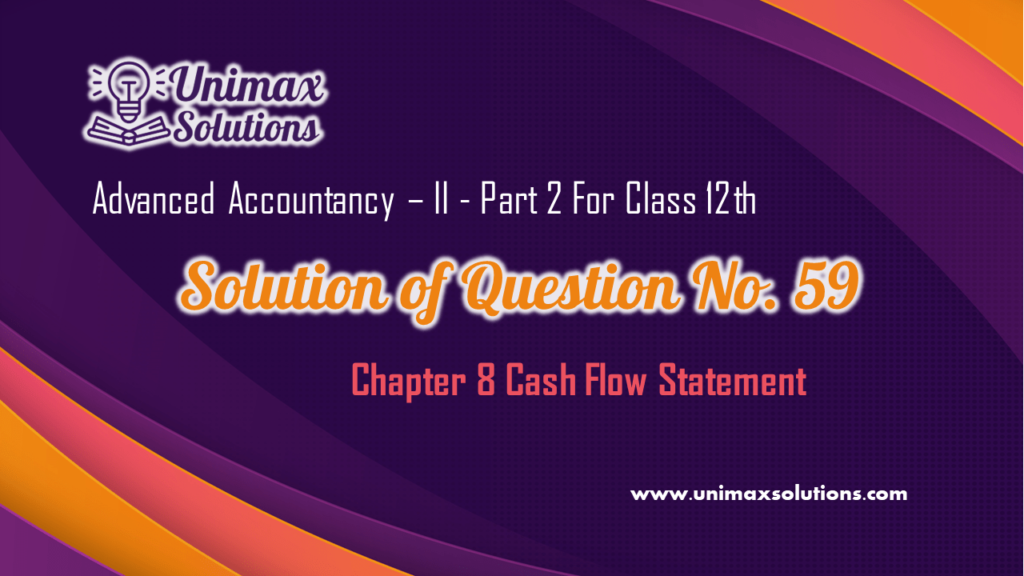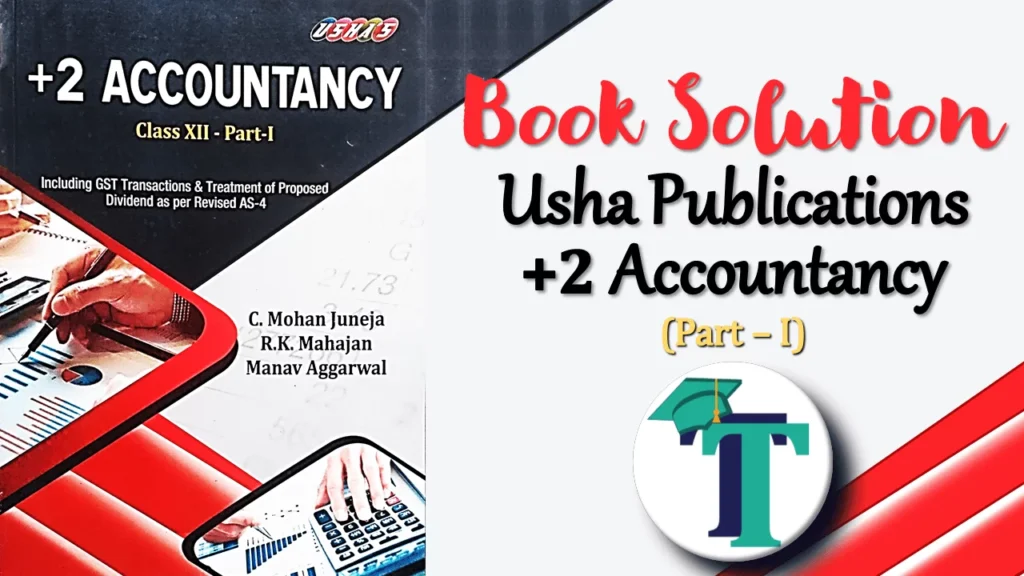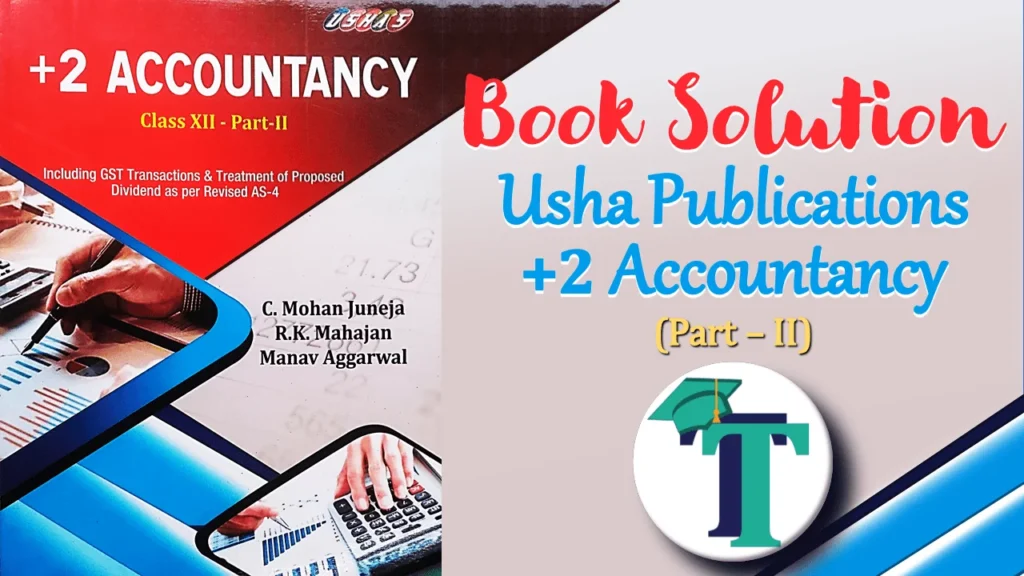
Advertisement
Question No 59 Chapter 8 – UNIMAX Class 12 Part 2 – 2021
59 From the following information, prepare a Cash Flow Statement:
BALANCE SHEETS AS AT…….
| Particulars | 31.3.2022 | 31.3.2021 |
| I. Equity and liabilities | ||
| (1) Shareholders’ funds | ||
| (a) Share capital | 1,00,000 | |
| (b) General reserve | 4,000 | 4,000 |
| Profit & loss account | ||
| (2) Non-current liabilities: | ||
| 15% debentures | 14,000 | 12,000 |
| (3) Current liabilities | ||
| (a) Cash credit | 13,600 | 34,000 |
| (b) Trade payable | 31,600 | 34,000 |
| (c) Short term provisions (provision for tax) | 8,400 | 6,000 |
| (d) Dividend payables | 2,000 | – |
| Total | 1,76,000 | 1,63,000 |
| II. Assets: | ||
| (1) Non-current assets: | ||
| Fixed assets | 80,000 | 82,000 |
| Less: accumulated Dep. | 30,000 | 22,000 |
| 50,000 | 60,000 | |
| (2) Current assets: | ||
| (a) Inventories | 70,000 | 60,000 |
| (b) Sundries debtors | 48,000 | 40,000 |
| (c) Prepaid expenses | 1,000 | 600 |
| (d) Current investment | 5,000 | 2,000 |
| Cash in hand | 2,000 | 400 |
| Total | 1,76,000 | 1,63,000 |
Additional Information:
(A) Contingent liability | 31.3.2022 Advertisement | 31.3.2021 |
Proposed dividend | 11,600 | 10,000 |
(B) Provision for tax made 9,400. Advertisement |
|
|
(C) Fixed assets sold for 10,000 their cost 20,000 and accumulated depreciation till date of sale is 6,000. |
|
Advertisement |
(D) An interim dividend paid during the year 9,000. |
|
|
The solution of Question No 59 Chapter 8 – UNIMAX Class 12 Part 2 – 2021 : –
CASH FLOW STATEMENT
FOR THE YEAR ENDED 31st MARCH . 2022
| Particulars | ₹ | ₹ |
| I. cash flow from operating activities | ||
| Net profit before tax (note 1) | 28,800 | |
| Adjustments for non-cash and non-operating items: | ||
| Add: depreciation 14,000 | ||
| Loss on sale of fixed assets 4000 | ||
| Interest on debentures 1,800 | 19,800 | |
| Operating profit before working capital change | 48,600 | |
| Less: increase in current assets | ||
| Inventories | ||
| Trade receivables 8,000 | ||
| Prepaid expenses 400 | ||
| Decrease in current liabilities: | ||
| Trade payable 2,400 | (20,800) | |
| Cash generated from operating activities | 27,800 | |
| Less: income tax paid | (7,000) | |
| Net cash from operating activities | 20,800 | 20,800 |
| B. cash flow from investing activities | ||
| Sale of fixed assets | 10,000 | |
| Purchase of fixed assets | (18000) | |
| Not cash used in investing activities | (8000) | (8000) |
| C. cash flows from financing activities | ||
| Issue of share capital | 20,000 | |
| Issue of debenture | 2,000 | |
| Interest on debenture | (1800) | |
| Decrease in cash credit | (11,400) | |
| Payment of proposed dividend (for 2021) | ||
| (10,000-dividend payable 2,000) | (8000) | |
| Interim dividend paid | (9000) | |
| Net cash used in financing activities | (8200) | (8200) |
| Net increase in cash and cash equivalents | 4600 | |
| Add: cash and cash equivalents in the beginning of the period | 2400 | |
| Cash and cash equivalents at the end of the period | 7,000 |
Working Notes:
| 1. Calculation of net profit before tax: | Amounts |
| Profit & loss a/c 31st march, 2022 | 2,400 |
| Less: profit & loss account 31st march, 2021 | 2,000 |
| 400 | |
| Add: proposed dividend | 10,000 |
| Interim dividend paid | 9,000 |
| Provision for tax made during the current year | 9,400 |
| 28,800 |
2. It is assumed that new debentures have been issued at the end of current accounting period. Hence interest on debentures is 15% on 12,000.
. Fixed asset account (On Original Cost)
| Particulars | ₹ | Particulars | ₹ |
| To Balance b/d | 82,000 | By Bank (sale) | 10,000 |
| To Bank (balancing figures, being purchase) | 18,000 | By Accumulated depreciation a/c | 6,000 |
| (Being depreciation on fixed asset sold) | |||
| By statements of P&L | 6,000 | ||
| (Loss on sale of fixed assets) | |||
| By Balance c/d | 80,000 | ||
| 1,00,000 | 1,00,000 |
End of Solution
Check Out the Solution of all questions for this chapter:
The solution to all questions of Chapter No. 8 – Cash Flow Statement Class 12 Unimax is shown as follows, click on the image of the question to get the solution.
Check out all books for PSEB
1. Comprehensive Solutions for All Chapters of Advanced Accountancy Part 1 Class 12 by Unimax
UnimaxSolutions.in offers a comprehensive solution for students studying Advanced Accountancy Part 1 in Class 12. With their meticulously curated study material, students can access comprehensive solutions to all the questions in each chapter. By selecting the chapter name from the study material, students can easily navigate through the topics and find detailed explanations and step-by-step solutions to the problems presented in that section. Whether it’s understanding complex accounting concepts, mastering calculation techniques, or analyzing financial statements, Unimax provides a valuable resource to aid students in their learning journey. With these comprehensive solutions at their disposal, students can enhance their understanding, clarify doubts, and improve their problem-solving skills in Advanced Accountancy, ensuring they are well-prepared for their Class 12 examinations.
- Chapter No. 1 – Accounts of Non-Profit Organisations
- Chapter No. 2 – Partnership Accounts – I (Basic Concepts)
- Chapter No. 3 – Partnership Accounts – II (Goodwill)
- Chapter No. 4 – Partnership Accounts – III (Change in Profit Sharing Ratio among Existing Partners)
- Chapter No. 5 – Partnership Accounts – IV (Admission of A Partner)
- Chapter No. 6 – Partnership Accounts – V (Retirement and Death of A Partner)
- Chapter No. 7 – Partnership Accounts – VI (Dissolution of Partnership Firm)
2. Comprehensive Solutions for All Chapters of Advanced Accountancy Part 2 Class 12 by Unimax
UnimaxSolutions.in presents an exceptional resource for students studying Advanced Accountancy Part 2 in Class 12. With their comprehensive study material, students can conveniently access extensive solutions to all the questions in each chapter. By simply selecting the desired chapter from the study material, students can effortlessly navigate through the topics and gain access to detailed explanations and step-by-step solutions to every problem presented in that particular section. Whether it involves understanding intricate accounting principles, honing calculation techniques, or analyzing complex financial statements, Unimax provides a valuable tool to support students in their learning journey. Equipped with these comprehensive solutions, students can enhance their comprehension, resolve any uncertainties, and strengthen their problem-solving abilities in Advanced Accountancy, empowering them to excel in their Class 12 examinations with confidence.
- Chapter No. 1 – Company Accounts (Share Capital)
- Chapter No. 2 – Issue of Debentures
- Chapter No. 3 – Redemption of Debentures
- Chapter No. 4 – Financial Statements of a Company (Balance Sheet Only)
- Chapter No. 5 -Financial Statement Analysis
- Chapter No. 6 – Tools/Methods of Financial Analysis
- Chapter No. 7 – Ratio Analysis
- Chapter No. 8 – Cash Flow Statement
Punjab School Education Board (PSEB) Solutions of Usha Publication.
If you’re a student enrolled in the Punjab School Education Board Class 12, exploring a wide range of books to cover the syllabus thoroughly is essential. While the prescribed textbooks are undoubtedly valuable, supplementing your studies with additional resources can enhance your understanding and knowledge. Consider checking out other books that align with the curriculum, offering different perspectives and insights on the subjects you’re studying. These supplementary materials can provide you with alternative explanations, practice questions, and examples that may aid in clarifying complex concepts. Moreover, exploring diverse sources can expose you to various writing styles and viewpoints, fostering a broader understanding of the subjects. So, seize the opportunity to expand your learning by delving into other books that can complement your studies and contribute to your academic growth.
Advertisement


